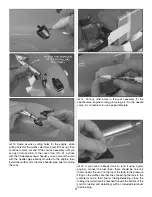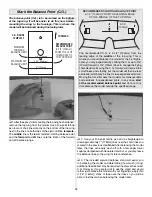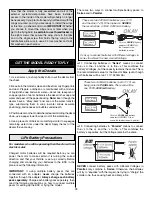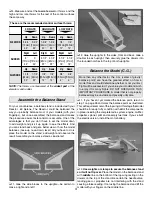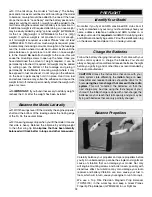
32
PREFLIGHT
Identify Your Model
No matter if you fl y at an AMA sanctioned R/C club site or if
you fl y somewhere on your own, you should always have your
name, address, telephone number and AMA number on or
inside your model. It is
required
at all AMA R/C club fl ying sites
and AMA sanctioned fl ying events. Fill out the identifi cation tag
on the decal sheet and place it on or inside your model.
Charge the Batteries
Follow the battery charging instructions that came with your
radio control system to charge the batteries. You should
always charge your transmitter and receiver batteries the night
before you go fl ying, and at other times as recommended by
the radio manufacturer.
CAUTION:
Unless the instructions that came with your
radio system state differently, the
initial
charge on
new
transmitter and receiver batteries should be done for 15
hours
using the slow-charger that came with the radio
system
. This will “condition” the batteries so that the
next charge may be done using the fast-charger of your
choice. If the initial charge is done with a fast-charger the
batteries may not reach their full capacity and you may be
fl ying with batteries that are only partially charged.
Balance Propellers
Carefully balance your propeller and spare propellers before
you fl y. An unbalanced prop can be the single most signifi cant
cause of vibration that can damage your model. Not only
will engine mounting screws and bolts loosen, possibly with
disastrous effect, but vibration may also damage your radio
receiver and battery. Vibration can also cause your fuel to
foam, which will, in turn, cause your engine to run hot or quit.
We use a Top Flite Precision Magnetic Prop Balancer
(TOPQ5700) in the workshop and keep a Great Planes
Fingertip Prop Balancer (GPMQ5000) in our fl ight box.
❏
3. If the tail drops, the model is “tail heavy.” The battery
pack and/or receiver could be moved forward to get the model
to balance, or weight could be added to the nose. If the nose
drops, the model is “nose heavy” and the battery pack and/or
receiver could be moved aft, or weight could be added to the
tail. If relocating the receiver and/or battery is not practical, or
if additional weight is still required after doing so, nose weight
may be easily added by using “spinner weight” (GPMQ4645
for the 1 oz. [28g] weight, or GPMQ4646 for the 2 oz. [57g]
weight). If spinner weight is not practical or is not enough,
or if tail weight is required, use Great Planes “stick-on” lead
(GPMQ4485). To fi nd out how much weight is required, place
incrementally increasing amounts of weight on the fuselage
over the location where it would be mounted inside until the
plane balances. A good place to add stick-on nose weight
is to the fi rewall.
Do not
attach weight to the cowl—this will
cause the mounting screws to open up the holes. Once you
have determined the amount of weight required, it can be
permanently attached. If required, tail weight may be added
by cutting open the bottom of the fuselage and gluing it
permanently inside.
Note:
If mounting weight where it may
be exposed to fuel or exhaust, do not rely upon the adhesive
on the back to permanently hold it in place. Over time, fuel
and exhaust residue may soften the adhesive and cause the
weight to fall off. Instead, permanently attach the weight with
glue or screws.
❏
4.
IMPORTANT:
If you found it necessary to add any weight,
recheck the C.G. after the weight has been installed.
Balance the Model Laterally
❏
1. With the wings level, lift the model by the engine propeller
shaft and the bottom of the fuselage under the trailing edge
of the fi n. Do this several times.
❏
2. If one wing always drops when you lift the model, it means
that side is heavy. Balance the airplane by adding weight
to the other wing tip.
An airplane that has been laterally
balanced will track better in loops and other maneuvers.
Summary of Contents for Reactor ARF
Page 36: ......




